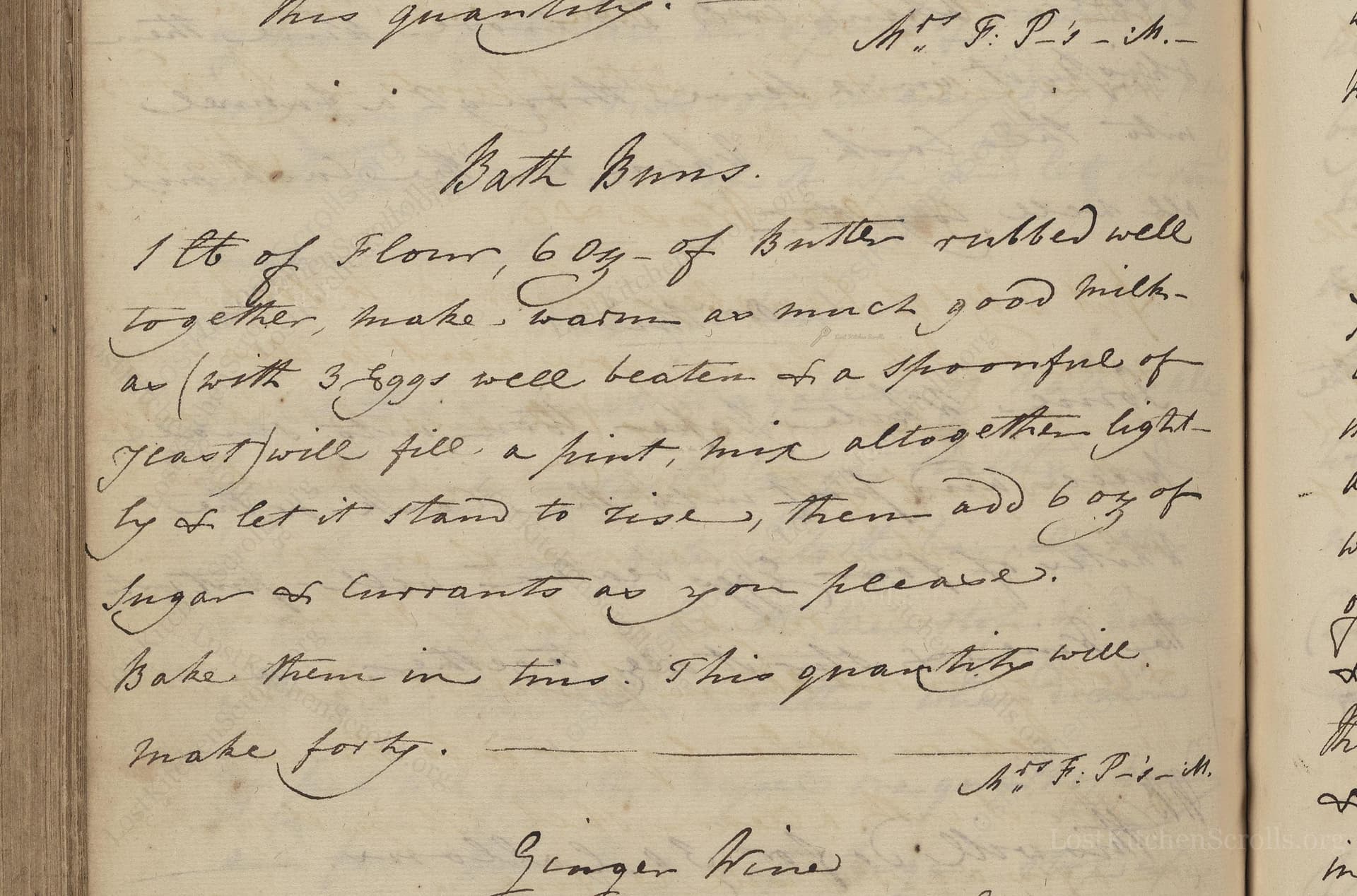
Bath Buns
"1 lb of Flour, 6 oz of butterr rubbed well together, make warm as much good milk as (with 3 eggs well beaten & a spoonful of yeast) will fill a pint, mix altogether light & let it stand to rise, then add 6 oz of sugar & currants as you please. Bake them in tins. This quantity will make forty."
Note on the Original Text
Early modern recipes such as this were terse, assuming the cook's experience in basic methods. Quantities were often broad, with a focus on proportional relationships ('as much milk' as needed). Yeast would have been brewer’s yeast or wild yeast from previous doughs, so modern dry yeast is a sensible substitution. Some spelling reflects period usage—'oz' for ounces, and lack of punctuation or explicit directions, trusting the baker to understand processes like kneading, proving, and shaping. The style is charmingly direct: blend, let rise, add sugar and currants, and bake—no superfluous steps.

Title
Cookery and medicinal recipes of M.W. (1775)
You can also click the book image above to peruse the original tome
Writer
Unknown
Era
1775
Publisher
Unknown
Background
A delightful glimpse into British kitchens of yesteryear, this manuscript collection—attributed simply to 'M. W.'—whisks readers through cherished recipes and culinary wisdom passed down between 1700 and 1850. A treasure trove for those who savor the artistry of historical cookery.
Kindly made available by
Folger Shakespeare Library
This Bath Buns recipe hails from an English manuscript dating sometime between 1700 and 1850, attributed to 'M. W.' The Bath Bun was a much-loved treat in Georgian and Regency-era England, most famously associated with the promenades and tea rooms of Bath spa, where visitors indulged in sweet, yeasted buns flecked with currants. During this period, home baking was a skill expected of accomplished households, though many treats were also acquired from local bakeries. Recipes were often written for high-quality ingredients like 'good milk' and fresh eggs, reflecting an era when ingredients were sourced locally and often produced on one's own estate.

In the 18th and early 19th centuries, Bath Buns would likely have been mixed by hand in large earthenware bowls, with butter rubbed into the flour using cool fingers. The dough would be left to rise in a warm corner of the kitchen, perhaps near the hearth. Eggs were beaten with wooden spoons, and the dough might be kneaded on a wooden board. Baking was typically done in metal or ceramic tins placed in a brick or cast-iron oven, fired by wood or coal.
Prep Time
30 mins
Cook Time
20 mins
Servings
40
We've done our best to adapt this historical recipe for modern kitchens, but some details may still need refinement. We warmly welcome feedback from fellow cooks and culinary historians — your insights support the entire community!
Ingredients
- 3 1/2 cups plain flour
- 6 oz unsalted butter
- 1 pint whole milk (may be slightly less; add just enough to reach 1 pint with eggs and yeast)
- 3 large eggs
- 1/2 oz active dry yeast (or 1 oz fresh yeast if available)
- 3/4 cup caster sugar
- 2/3 cup currants (more or less to taste)
Instructions
- To make Bath Buns in the modern kitchen, begin by combining 3 1/2 cups of plain flour with 6 ounces of cold butter, rubbing them together until the mixture resembles breadcrumbs.
- Warm enough full-fat milk so that, when combined with 3 large eggs (lightly beaten) and 1 tablespoon (about 1/2 ounce) of active dry yeast, the mixture totals about 1 pint.
- Mix these wet and dry ingredients lightly, forming a soft, enriched dough.
- Let the dough rise in a warm place until doubled in size, which may take 1 to 2 hours.
- Once risen, gently knead in 3/4 cup of caster sugar and as many currants as desired—start with about 2/3 cup.
- Shape the dough into small buns, place them on lined baking tins, and let them rest until slightly puffed.
- Bake in a preheated oven at 350°F (fan 320°F) for 15-20 minutes until golden.
- This quantity should yield around forty petite buns.
Estimated Calories
120 per serving
Cooking Estimates
Preparing and shaping the dough takes around 30 minutes. The buns need 1 to 2 hours to rise before baking. Baking takes about 15-20 minutes. Each bun has about 120 calories, and the recipe makes roughly 40 small buns.
As noted above, we have made our best effort to translate and adapt this historical recipe for modern kitchens, taking into account ingredients nowadays, cooking techniques, measurements, and so on. However, historical recipes often contain assumptions that require interpretation.
We'd love for anyone to help improve these adaptations. Community contributions are highly welcome. If you have suggestions, corrections, or cooking tips based on your experience with this recipe, please share them below.
Join the Discussion
Rate This Recipe

Den Bockfisch In Einer Fleisch Suppen Zu Kochen
This recipe hails from a German manuscript cookbook compiled in 1696, a time whe...

Die Grieß Nudlen Zumachen
This recipe comes from a rather mysterious manuscript cookbook, penned anonymous...

Ein Boudain
This recipe comes from an anonymous German-language manuscript cookbook from 169...

Ein Gesaltzen Citroni
This recipe, dating from 1696, comes from an extensive anonymous German cookbook...
Browse our complete collection of time-honored recipes



